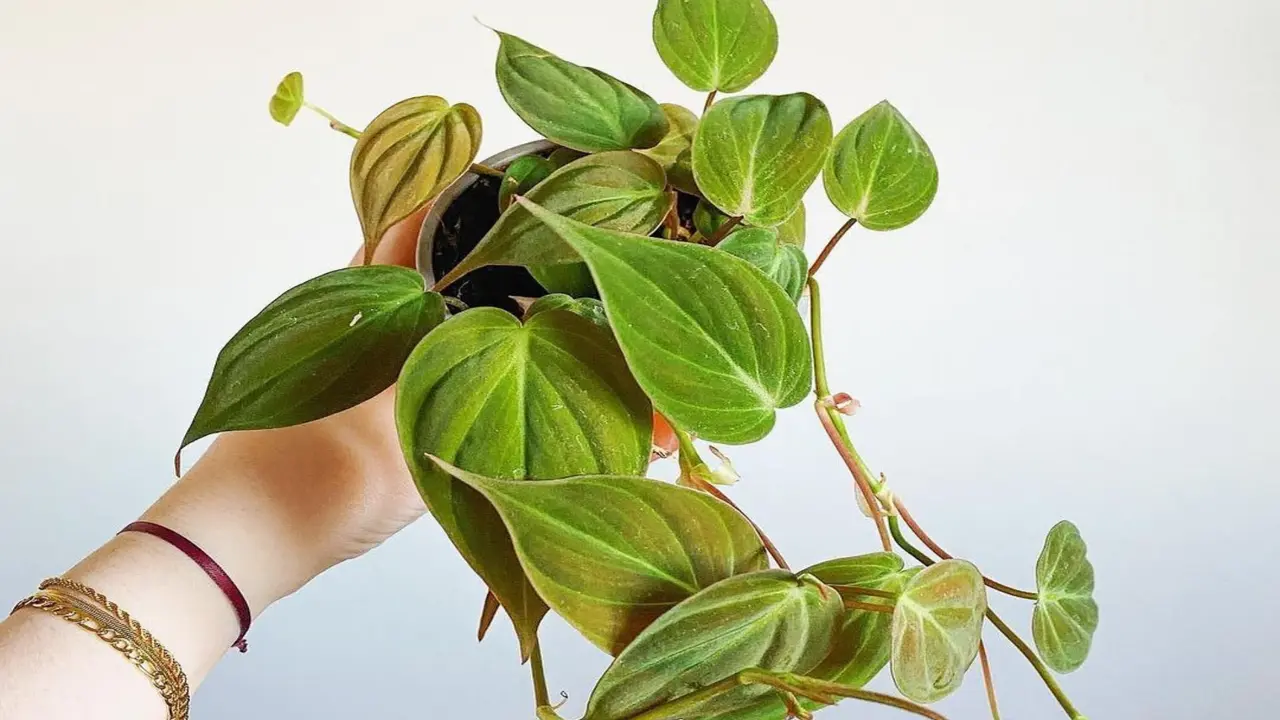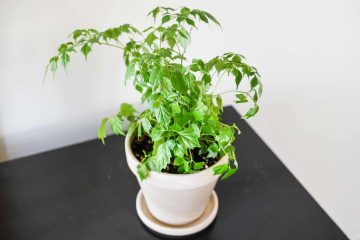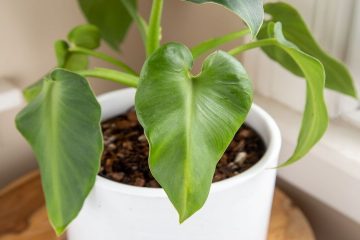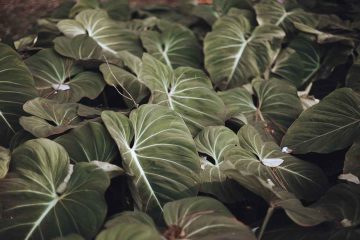Philodendron Micans, with its velvety, heart-shaped leaves and rich green to bronze hues, is a delightful addition to any indoor plant collection. Easy to care for and visually stunning, this tropical beauty thrives in low to medium light, making it perfect for adding a touch of nature to your home. Whether you’re a seasoned plant enthusiast or just starting your green journey, Philodendron Micans is a fantastic choice. Philodendron Micans belongs to an Araceae family like a popular plant Philodendron Rugosum. Let’s dive into how to grow, care for, and propagate this gorgeous plant, and learn about the common pests and diseases to watch out for to keep your Micans healthy and happy.
| Botanical Name | Philodendron hederaceum var. hederaceum |
| Common Name | Philodendron micans, velvet-leaf philodendron |
| Family | Araceae |
| Plant Type | Perennial |
| Mature Size | 8 in. tall, 24 in. long |
| Sun Exposure | Partial |
| Soil Type | Loamy, moist but well-drained |
| Soil pH | Acidic |
| Bloom Time | Spring, summer |
| Flower Color | Green, white |
| Hardiness Zones | 10a, 10b, 11a, 11b |
| Native Area | North America, Central America |
| Toxicity | Toxic to cats, toxic to dogs |
Philodendron Micans Care
Philodendron Micans, with its velvety heart-shaped leaves, is a stunning and easy-to-care-for houseplant that adds elegance to any indoor space. Below, we’ll describe how to grow and care for this tropical beauty, ensuring it thrives in your home.
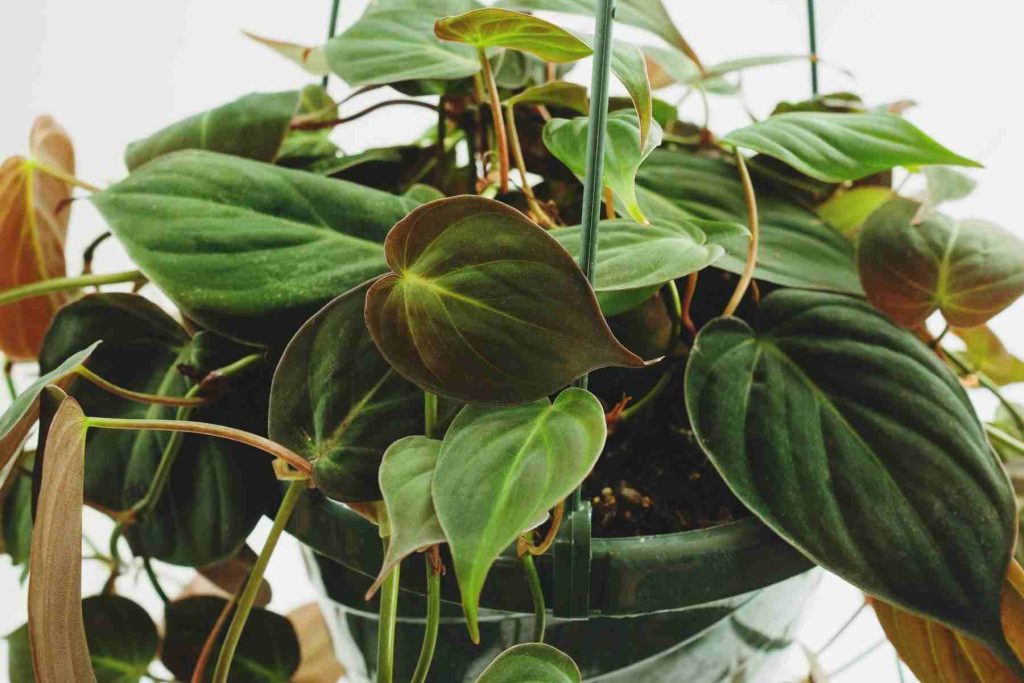
Light Requirements
Philodendron Micans thrives in bright, indirect light, mimicking its native tropical environment. Place it near a north or east-facing window for optimal growth. Direct sunlight can scorch the delicate leaves, causing damage. If natural light is insufficient, a grow light can be a great alternative. Micans Philodendron also adapts well to low-light conditions, making it a versatile houseplant. However, low light can slow its growth and reduce the vibrancy of its leaves. Regularly rotate the plant to ensure even light exposure and prevent leggy growth.
Watering Needs
Watering Philodendron Micans properly is crucial for its health. Water the plant when the top inch of soil feels dry to the touch. Avoid overwatering, as this can lead to root rot. Use a pot with drainage holes to prevent water from pooling at the bottom. During the growing season, typically spring and summer, Micans Philodendron may require more frequent watering. In contrast, reduce the frequency during the dormant winter months. Always use room-temperature water to avoid shocking the roots.
Soil and Potting
Micans Philodendron prefers well-draining, aerated soil. A mix of peat, perlite, and pine bark works well, allowing roots to breathe while retaining moisture. Repotting every two years or when the plant outgrows its pot helps prevent root-bound issues. Choose a pot with drainage holes to avoid waterlogged soil. When repotting, gently loosen the roots and refresh the soil mix. This process rejuvenates the plant, promoting healthier growth. Proper potting ensures the Micans Philodendron stays vibrant and lush.
Temperature and Humidity
Philodendron Micans flourishes in temperatures between 65°F to 80°F (18°C to 27°C). It’s important to keep the plant away from cold drafts and sudden temperature changes. High humidity levels, ideally above 50%, are beneficial for its growth. To increase humidity, consider using a humidifier, placing a tray of water nearby, or misting the leaves regularly. The tropical nature of Micans Philodendron makes it thrive in humid conditions, which helps maintain its lush, velvety foliage.
Fertilizing Tips
Fertilizing Micans Philodendron is essential for robust growth. Use a balanced, water-soluble fertilizer every four to six weeks during the growing season. Dilute the fertilizer to half the recommended strength to avoid over-fertilization, which can burn the roots. Organic options like worm castings or compost tea are also effective. Reduce feeding during the fall and winter months when the plant’s growth slows down. Regular fertilization ensures that Micans Philodendron receives the necessary nutrients for vibrant, healthy foliage just like Philodendron Brasil.
Pruning and Maintenance
Regular pruning keeps Philodendron Micans in shape and encourages bushier growth. Trim any leggy, yellowing, or damaged leaves using sterilized scissors to maintain the plant’s aesthetic appeal. Removing old foliage allows the plant to focus energy on new growth. Additionally, pinching back the tips can promote a fuller, more compact appearance. Regular cleaning of the leaves with a damp cloth helps prevent dust buildup, ensuring the plant can photosynthesize efficiently.
How To Propagate Philodendron Micans?
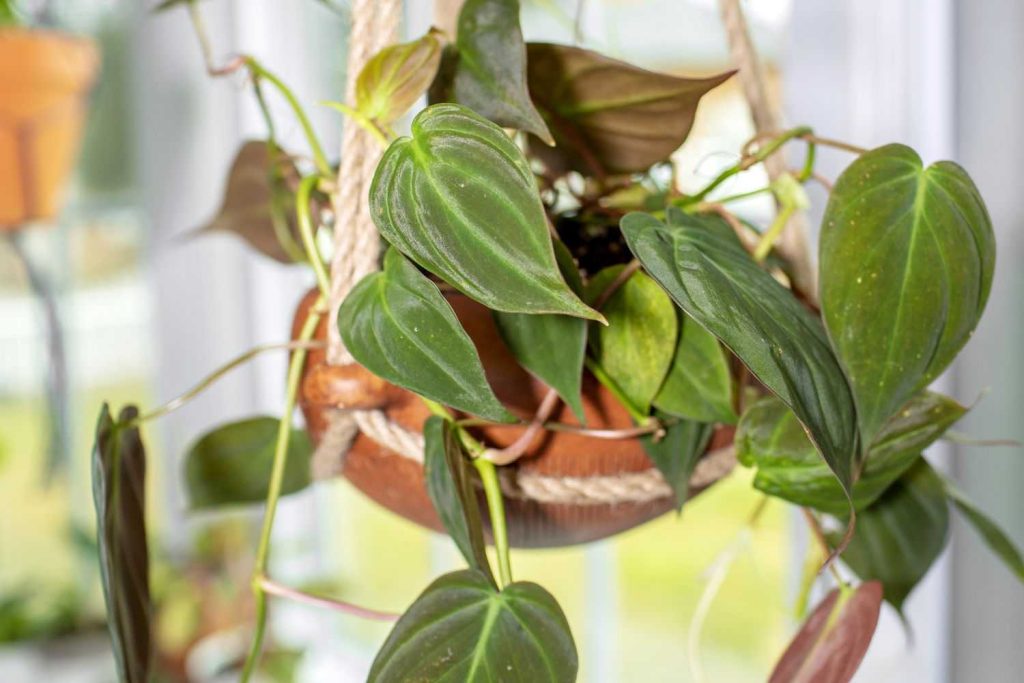
Philodendron micans, also known as Velvet Leaf Philodendron, is prized for its beautiful, velvety leaves and trailing habit. Propagating this plant is relatively straightforward and can be done using stem cuttings. Here is a detailed guide on how to propagate Philodendron micans:
Materials Needed
- Healthy Philodendron micans plant
- Sharp, clean scissors or pruning shears
- A clean glass or jar
- Fresh, room temperature water
- Rooting hormone (optional)
- Potting mix suitable for aroids (philodendrons)
- Small pots or containers
Step-by-Step Guide
1. Choose a Healthy Stem
Select a healthy stem from the Philodendron micans plant. Look for a stem with several nodes (the small bumps along the stem where leaves and roots grow) and at least one or two leaves.
2. Make the Cut
Using sharp, clean scissors or pruning shears, cut the stem just below a node. Ideally, the cutting should be about 4-6 inches long and include a few nodes and leaves.
3. Remove Lower Leaves
Remove the leaves from the lower part of the cutting, leaving at least one or two leaves at the top. This will help the cutting focus its energy on developing roots rather than maintaining leaves.
4. (Optional) Dip in Rooting Hormone
Although not necessary, dipping the cut end of the stem in rooting hormone can encourage faster root development. This step is optional but can be beneficial.
5. Place the Cutting in Water
Fill a clean glass or jar with fresh, room temperature water. Place the cutting in the water, ensuring that at least one or two nodes are submerged. Avoid submerging the leaves as this can cause them to rot.
6. Provide Proper Conditions
Place the jar in a bright, indirect light location. Avoid direct sunlight, which can scorch the cutting. Change the water every few days to keep it fresh and prevent bacterial growth.
7. Wait for Roots to Develop
Roots should begin to develop in about 2-4 weeks. You’ll know the cutting is ready to be potted when the roots are at least 1-2 inches long.
8. Potting the Cutting
Once the roots are sufficiently long, it’s time to pot the cutting. Fill a small pot or container with a well-draining potting mix suitable for aroids. Make a hole in the soil and gently place the rooted cutting into it. Firmly but gently press the soil around the base of the cutting to secure it.
9. Water and Care
Water the newly potted cutting thoroughly, allowing excess water to drain out. Place the pot in a bright, indirect light location. Continue to care for the new plant as you would a mature Philodendron micans, keeping the soil slightly moist but not waterlogged.
Tips for Successful Propagation
- Temperature: Philodendron micans prefer warm temperatures (65-80°F or 18-27°C). Keep the cuttings in a warm area to encourage root growth.
- Humidity: Higher humidity levels (around 60-70%) can aid in the rooting process. Consider placing the jar in a humidity tray or using a humidifier if your environment is dry.
- Patience: Some cuttings may take longer to root than others. Be patient and avoid disturbing the cutting too frequently.
Troubleshooting
- Yellowing Leaves: If the leaves of the cutting start to yellow, it could be due to overwatering, underwatering, or too much direct sunlight. Adjust the care accordingly.
- No Roots: If there are no roots after several weeks, try changing the water more frequently or moving the cutting to a slightly warmer location. Using rooting hormone can also help.
Common Pests & Diseases of Philodendron Micans
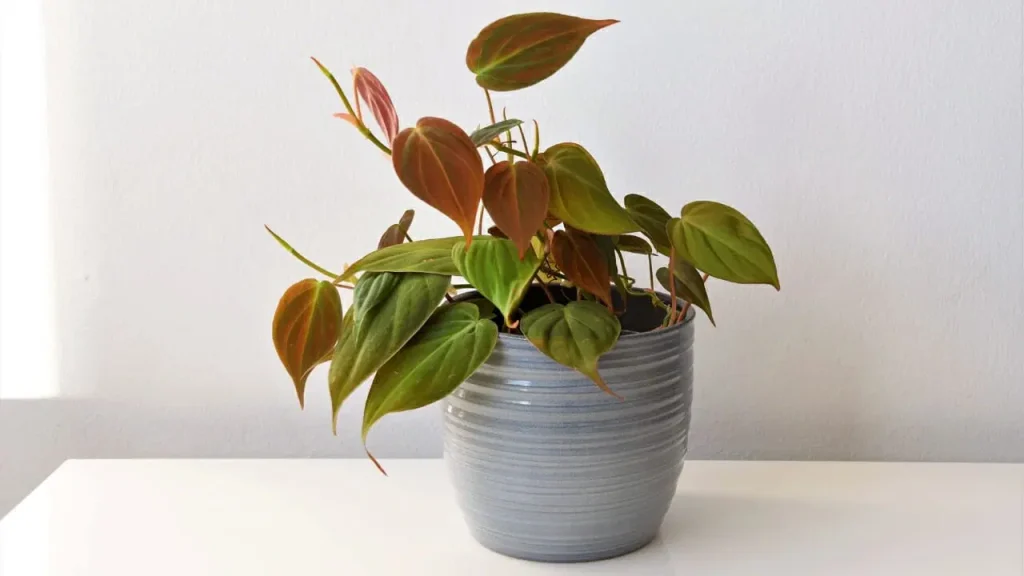
Philodendron Micans, like other philodendron species, can be affected by various pests and diseases. Here are some common ones to watch out for:
Common Pests
- Spider Mites:
- Symptoms: Tiny webs, yellowing or speckled leaves.
- Treatment: Increase humidity, wash leaves with soapy water, and use insecticidal soap or neem oil.
- Aphids:
- Symptoms: Sticky residue on leaves, distorted new growth, clusters of small insects on new growth.
- Treatment: Spray with water, use insecticidal soap or neem oil, and introduce natural predators like ladybugs.
- Mealybugs:
- Symptoms: White, cotton-like masses on leaves and stems.
- Treatment: Wipe with alcohol-soaked cotton swabs, use insecticidal soap or neem oil.
- Scale Insects:
- Symptoms: Brown or black bumps on stems and leaves, honeydew residue.
- Treatment: Scrape off with a soft brush, use insecticidal soap or horticultural oil.
Common Diseases
- Root Rot:
- Symptoms: Yellowing leaves, mushy stems, and roots.
- Prevention/Treatment: Ensure well-draining soil, avoid overwatering, and treat with a fungicide if necessary.
- Leaf Spot:
- Symptoms: Brown or black spots on leaves.
- Prevention/Treatment: Remove affected leaves, improve air circulation, avoid overhead watering, and use a fungicide.
- Bacterial Blight:
- Symptoms: Water-soaked lesions on leaves that turn brown and mushy.
- Prevention/Treatment: Remove affected areas, avoid overhead watering, and use a copper-based fungicide.
- Powdery Mildew:
- Symptoms: White, powdery substance on leaves.
- Prevention/Treatment: Improve air circulation, avoid high humidity, and use a fungicide.
Preventative Measures
- Proper Watering: Avoid overwatering and ensure good drainage.
- Humidity Control: Maintain high humidity but ensure good air circulation.
- Cleanliness: Keep the plant and its surroundings clean to prevent pest infestations.
- Regular Inspection: Regularly check for early signs of pests and diseases to address them promptly.
Philodendron Micans Variegated
Philodendron Micans Variegated is a stunning houseplant known for its heart-shaped leaves and striking variegation. The leaves feature a rich, dark green color with splashes of creamy white or pale yellow, creating a beautiful contrast that adds elegance to any space. This trailing plant thrives in bright, indirect light but can tolerate lower light conditions, making it versatile for indoor environments. It prefers well-draining soil and requires moderate watering, allowing the top inch of soil to dry out between waterings. Regular pruning encourages bushier growth, and occasional fertilization during the growing season promotes vibrant foliage. With proper care, this plant becomes a captivating focal point in your home.

